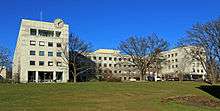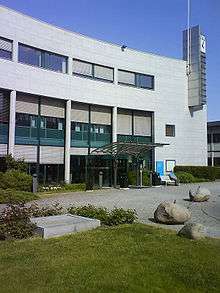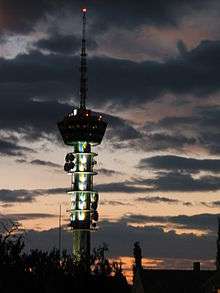NRK
NRK (an abbreviation of the Norwegian: Norsk rikskringkasting AS, generally expressed in English as the Norwegian Broadcasting Corporation) is the Norwegian government-owned radio and television public broadcasting company, and the largest media organisation in Norway. All other TV channels, broadcast from Norway, were banned from 1960 until 1981. NRK broadcasts three national TV channels and three national radio channels on digital terrestrial television, digital terrestrial radio and subscription television. All NRK radio stations are being streamed online at NRK.no, which also offers an extensive TV service. NRK is a founding member of the European Broadcasting Union.[3]
 NRK's current corporate logo since 1969. Current version of NRK's current corporate logo since 1999 | |
Native name | Norsk rikskringkasting (NRK) |
|---|---|
| Publicly funded, public-service broadcaster | |
| Industry | Broadcasting |
| Predecessor | Kringkastningsselskapet A/S (1925) |
| Founded | 1 July 1933[1] |
| Headquarters | Oslo, Norway |
Key people | Thor Gjermund Eriksen |
| Products | |
| Owner | Government of Norway |
Number of employees | 3,419; 266 temporary staff (2017)[2] |
| Website | nrk |
Financing
Until 01.01.2020 About 94% of NRK's funding comes from a mandatory annual licence fee payable by anyone who owns or uses a TV or device capable of receiving TV broadcasts. The remainder comes from commercial activities such as programme and DVD sales, spin-off products, and certain types of sponsorship. NRK's license income in 2012 was more than 5 billion kroner. In the autumn of 2015, the government announced that it planned to change the way NRK is financed. This is in part a reaction to the decline of TV ownership in Norway. From 01.01.2020 the NRK funding is an item in the national budget and the costs are covered through taxation for each individual liable for income taxes in Norway.
History
Kringkastningsselskapet A/S, a privately owned company and the predecessor of NRK, started regular radio broadcasts in Norway in 1925. NRK itself was founded in 1933. Based on a model similar to that of the BBC and located in Oslo, it was a replacement for privately operated radio stations in larger cities. NRK initially set out to cover the entire country and had a monopoly on broadcasting in Norway. The monopoly came under intense pressure when Norwegian TV companies began broadcasting from abroad in addition to international cable TV. Cable TV started in 1982 and satellite TV in 1986 (the launch of TV3 in 1987 and TVNorge in 1988). It was not until the launch of TV 2 on 5 September 1992, that NRK's monopoly on television broadcasting in Norway ended.
During the Nazi German occupation, Norwegian transmitters were used to broadcast Nazi German war propaganda to Northern Europe (particularly Scotland and the northern half of Ireland, where the sea path ensured a good signal) and Scandinavia.
Prior to the Nazi German occupation, NRK had also been partly financed by radio commercials.
NRK was one of 23 founding broadcasting organisations of the European Broadcasting Union, which was founded in 1950. In 1954, NRK started broadcasting television shows, on a trial basis. Regular broadcasts started in 1960.
In 1969, NRK adopted its current corporate logo which consists of the lowercased "nrk" wordmark that has the letter "n" being made up of a rectangle and a reversed-italic rectangle, the letter "r" being made up of a rectangle and a circle, and the letter "k" being made up of a rectangle and reflecting-mirrored italic rectangles. This became the current corporate logo for NRK and it is having a long use throughout today.
NRK was the last of the major European public broadcasters to introduce a second radio station, officially starting as late as 1984. In 1993, NRK launched a third radio station, the youth-oriented P3. A 24-hour station for classical music, Alltid Klassisk (now called "NRK Klassisk"), introduced in 1995, was the first of its kind to be broadcast digitally using digital audio broadcasting. The 24-hour news station Alltid Nyheter started in 1997, followed by a radio station for teenagers, mP3 in 2000, which mostly plays dance music.
On 1 September 1996, a second television channel called NRK2 was launched. The original television channel is now known as NRK1. On 3 September 2007, NRK launched its third channel: a youth channel called NRK3. Later that year, on 1 December, NRK launched its fourth television channel, NRK Super, which is aimed at children. NRK3 and NRK Super share the same channel, with NRK Super broadcasting from 06:00 to 19:30 and NRK3 from 19:30 to 06:00.
In 1999, following NRK Interaktiv's relaunch as NRK.no, NRK redesigned its current corporate logo (that were introduced in 1969), so that it could be similar to its old version. This new version of NRK's current corporate logo made its first appearance in an ident in 2000 by making its overhaul to NRK's radio and television channels.
A traditional music radio station, NRK Alltid folkemusikk (now known as "NRK Folkemusikk") was launched in 2004 on DAB and internet radio.

NRK's international radio transmissions, known as Utenlandssendingen, began shortwave transmission in 1948. Initially broadcasting in Norwegian, English-language programs were added later. The service was discontinued on 1 January 2002. All NRK broadcasting activities on shortwave ceased on 1 January 2004. NRK's mediumwave transmitter at Kvitsøy on 1314 kHz used to be widely heard internationally and was one of the most commonly heard trans-Atlantic DX signals in eastern North America. The frequency carried a mixture of NRK's radio channels P1 and P2, and was called Europakanalen (literally "The Europe Channel"). However, these mediumwave transmissions were discontinued on 1 July 2006.
All of NRK's radio stations are now available on the internet. Several of NRK's television programmes are also available on the internet.
On 16 April 2015, the Norwegian Ministry of Culture announced its intention to eventually switch off all FM transmitters in the country, with the first such transmitter expected to be switched off on 11 January 2017, therefore making Norway the first country in the world to completely transition to digital radio. According to the Ministry of Culture, the decision was justified because transmitting through the FM network was eight times more expensive than transmitting through digital audio broadcasting, and because only five national radio stations are transmitting on FM, compared to the 42 digital radio stations allocated in Norway, with 22 stations transmitting on the latter. NRK Radio is expected to transition from FM to digital radio before commercial radio stations do so.[4][5][6]
NRK claimed to have the longest-running radio show, Lørdagsbarnetimen (The Saturday Children's Hour), which ran from 20 December 1924 until 11 September 2010.
Organisation

The CEO began major organisational changes in 2008, with the aim of creating a more agile NRK, while still adhering to the principles of the broadcaster-producer model introduced in January 2001. By January 2009, the number of programme-producing divisions had been reduced from five to three, separated more along geographical than functional lines, and at the same time simplifying trading in the internal market. The programme-producing divisions are:
- Marienlyst covering all facilities in Oslo
- Distrikt, encompassing all regional offices and with their headquarters in Trondheim
- Sami, the producer of Sámi programmes situated in Karasjok
Thor Gjermund Eriksen has been director-general of the Norwegian Broadcasting Corporation since 12 March 2013.[7] The previous directors were Olav Midttun (1934–1947, except during the Nazi occupation), Kaare Fostervoll (1948–1962), Hans Jacob Ustvedt (1962–1971), Torolf Elster (1972–1981), Bjartmar Gjerde (1981–1988), Einar Førde (1989–2001), John G. Bernander (2001–2007)[8] and Hans-Tore Bjerkaas (2007-2012). After WW2, all but Hans-Tore Bjerkaas and John G. Bernander had been active politically in socialist parties. The current director-general, Thor Gjermund Eriksen, came from Sosialistisk Venstre parti(SV), a membership he resigned 4 days before the date of accession.
The chairman of the board is Birger Magnus, Marius Lillelien heads the broadcasting department, and the head of the news department is Marius Tetlie.[9] In 2017, NRK employed 3 419 and 266 temporary staff.[10]
Notable television programmes
NRK productions
- Dagsnytt Atten
- Dagsrevyen
- Melodi Grand Prix (The Norwegian national selection for Eurovision Song Contest)
- Nytt på nytt
- Skam
- Skavlan and Først & sist
- Urix
Channels
Radio
- NRK P1 - generalist channel, with regional opt outs
- NRK P2 - cultural channel
- NRK P3 - youth oriented channel
- NRK Alltid Nyheter - 24/7 news
- NRK Båtvær - 24/7 weather forecast on DAB only
- NRK Folkemusikk - 24/7 Traditional Norwegian folk music
- NRK P1+ - A spinoff of P1, targeting a mature audience
- NRK P13 - 24/7 rock and indie music
- NRK Jazz
- NRK Klassisk - 24/7 classical music
- NRK mP3 - 24/7 dance music (also called mP3)
- NRK Sápmi - in Sami languages
- NRK Sport - 24/7 sports channel
- NRK Stortinget - broadcasts when parliament (Storting) is in session.
- NRK Super - 24/7 for children
Regional broadcasting
NRK has 12 regional offices around Norway. Each office has its own broadcasts on both television (on NRK 1) and radio (on NRK P1), as well their own news sites on the internet. They also contribute news coverage to national news programmes. NRK's headquarters are at Marienlyst in Oslo and Tyholt in Trondheim.
FM radio switch-off
Norway was the first country to announce a complete switch-off of national FM radio stations, including NRK P1 with regional services, NRK P2 and NRK P3, NRK mP3 and NRK Alltid Nyheter. Switch off started on 11 January 2017, and ended on 13 December 2017.
From 2018, all FM transmitters are replaced with broadcast via DAB +, internet and cable.[11]
High definition
NRK has an HD outside broadcast van, producing high-definition video.[12] The first Norwegian series filmed in HD was En Udødelig Mann ("An Immortal Man") about the young Henrik Ibsen. The action six-part miniseries called Kodenavn Hunter was also filmed in HD. Promotional videos are freely downloadable from NRK's site, and the full-length last episode is available.[13]
NRK uses H.264 as the compression codec for the digital terrestrial network which is commonly used to compress videos stored as mp4.[14]
NRK has also started to offer HD content via BitTorrent. This is currently a very limited offer due to rights restrictions, but it is growing steadily.[15]
In preparation for the Winter Olympic Games in Vancouver, NRK announced that they would launch a high-definition channel, and their first native HD broadcast would be from Vancouver. NRK1 HD is a simulcast of NRK1.[16]
See also
- List of Norwegian-language radio stations
- List of Norwegian television channels
- List of NRK regional services
- List of programs broadcast by Norsk rikskringkasting
- NORMOB
- yr.no
References
- "NRK fyller 80 år" (in Norwegian). nrk.no. 2013-06-29. Retrieved 2015-08-10.
- "Årsregnskapet 2017 (Annual Report)" (PDF) (in Norwegian). nrk.no. Retrieved 2018-08-08.
- "about NRK - information in other languages". Nrk.no. Retrieved 2014-05-17.
- "Norway announces nationwide FM radio shut-off". Venturebeat. Retrieved 2015-04-26.
- "Norway will lead the effort to switch off FM radio". Engadget. Retrieved 2015-04-26.
- "FM radio switch-off looms in Norway". BBC News. Retrieved 2015-04-26.
- Nina Berglund: New NRK boss gets down to work Views and News from Norway, 12 March 2012
- "Kringkastingssjefene - Om NRK - Organisasjon". Nrk.no. Retrieved 2014-05-17.
- "Slik er NRK organisert" (in Norwegian). nrk.no. Retrieved 2018-08-08.
- "Årsregnskapet 2017 (Annual Report)" (PDF) (in Norwegian). nrk.no. Retrieved 2018-08-08.
- "Norveška ukinja FM-radio". Val 202.
- "Skandinavias mest avanserte". Nordic Media Festival. Archived from the original on 2007-08-10. Retrieved 2007-08-15.
- "Hunter - NRK". 20.nrk.no. Archived from the original on 2013-10-27. Retrieved 2014-05-17.
- "Overgangen til digitalt bakkenett – Norges televisjon (NTV)". Ntv.no. Retrieved 2014-05-17.
- "NRKBeta - Bittorrent (Norwegian)". Norwegian Broadcasting Corporation. Retrieved 2009-04-24.
- "NRK1 i HD fra 12. February 2010 (Norwegian)". Norwegian Broadcasting Corporation. Retrieved 2010-02-09.
External links
| Wikimedia Commons has media related to Norsk rikskringkasting. |
- Official website (in Norwegian)
- About NRK (in English)
- NRK's History in Brief (in English)
- NRK's Channels (in English)
- Television schedules
- NRK Media Player for TV (Available for Norwegian IP addresses only)
- Radio schedules, Internet radio
- NRK Media Player for Radio
- yr.no: Online weather service (in Norwegian and English)
- ut.no: Hiking traimls and cabins (in Norwegian)
